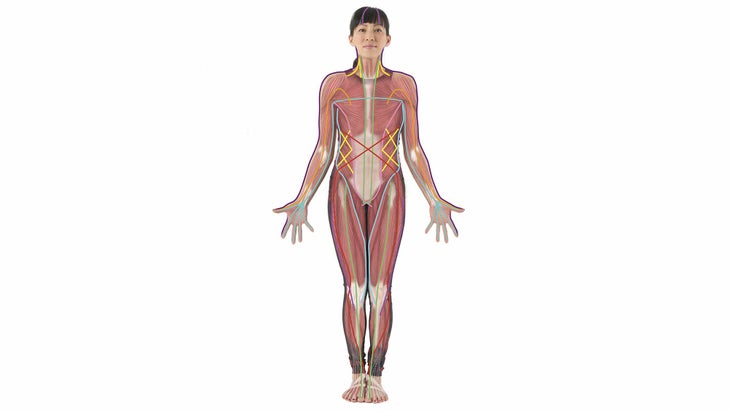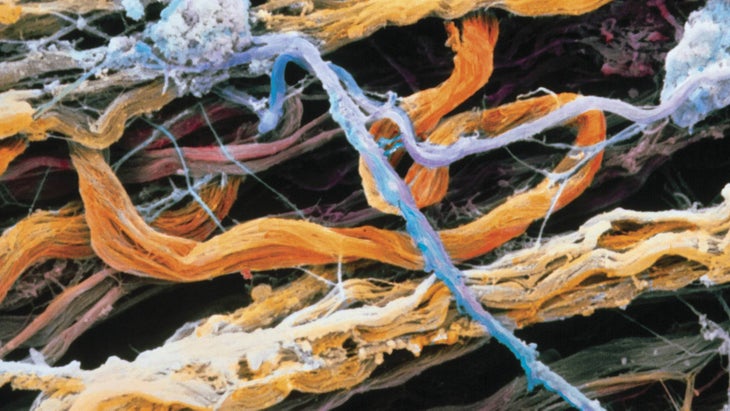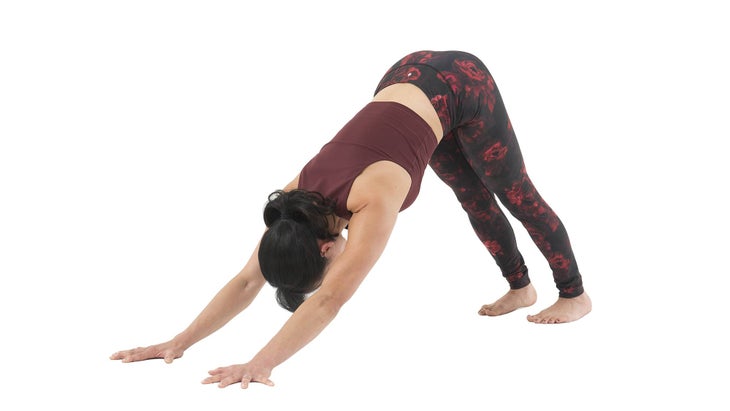Heading out the door? Read this article on the new Outside+ app available now on iOS devices for members! Download the app.

If I asked you what a heart is like, chances are you’d say it’s like a pump. The lungs are often described as “bellows,” the kidneys “a filter,” the brain “a computer.” We tend to view the body in mechanical terms because we live in an industrial age—and because the body has been described as a “soft machine” ever since the scientist René Descartes coined the term in the early 17th century.
So it comes as no surprise that most anatomy books show you body parts—this muscle, that ligament—as if we’re assembled part by part like a car or an iPhone. But instead of timing belts and motherboards, we have hamstrings and biceps. An anatomy atlas is a helpful tool for learning, but the error comes when we start thinking that humans are actually built that way. What is actually going on under your skin is so different from what’s in those pictures.
Why Fascia Matters
However, your body is much more like a plant than a machine. We are grown from a tiny seed—a single cell, or fertilized ovum, about the size of a pin prick—not glued together in parts. This seed contains sufficient instructions (given the proper nourishment) to create a helpless, squalling baby, who turns into an energetic toddler, a feckless teenager, and then finally a mature adult.
By the time we’re adults, we consist of approximately 70 trillion cells, all surrounded by a fluid fascial network—a kind of sticky yet greasy fabric that both holds us firmly together, yet constantly and miraculously adjusts to accommodate our every movement.
The traditional biomechanical theory of the musculoskeletal system says that muscles attach to bones via tendons that cross the joints and pull bones toward each other, restricted by other “machine parts” called ligaments. But all these anatomical terms, and the separations they imply, are false. No ligaments exist on their own; instead they blend into the periosteum—vascular connective tissue that serves as cling-wrap around the bones—and the surrounding muscles and fascial sheets. What this means is that you weren’t assembled in different places and glued together—rather, all your parts grew up together within the glue.
For example, the triceps are wedded by fascial fabric to their neighboring muscles north, south, east, and west, as well as to the ligaments deep in both the shoulder and elbow. If you contract the triceps in Plank Pose, all these other structures will have an effect and be affected. Your whole body engages in the action—not just your triceps, pectoral, and abdominal muscles.
The takeaway for yoga? When you do poses, it is useful to put your attention anywhere and everywhere in your body—not just the obviously stretched and singing bits. A release in your foot can help your hip; a change of your hand position can ease your neck.
See also Fascia: The Flexibility Factor You’re Probably Missing on the Mat
Understanding the Network of Fascia in the Body
The fluid fascial network that lives between each cell in your body consists of bungee cord–like fibers made mostly from collagen, including reticulin, and elastin. These fibers run everywhere—denser in certain areas such as tendons and cartilage, and looser in others like breasts or the pancreas.
The other half of the fascial network is a gel-like web of variable mucopolysaccharides, or mucus. Basically, your cells are glued together with snot, which is everywhere, and is more or less watery (hydrated) depending on where it is in the body and what condition it’s in.
All the circulation in your body has to pass through these fibrous and mucousy webs. Generally speaking, the denser the fibers and the drier the mucous, the less the fascial web allows molecules to flow through it: nourishment in one direction and waste in the other. Yoga helps both stretch and ease the fiber webbing, as well as hydrate the gel, making it more permeable.
New research shows that this web of proteins runs down through the membranes of each cell and connects both aspects of the connective-tissue web through the cytoskeleton to the cell nucleus. This means that when you’re doing yoga stretches, you are actually pulling on your cells’ DNA and changing how it expresses itself. Thus, the mechanical environment around your cells can alter the way your genes function.
We’ve known for a while that the chemical environment (hormones, diet, stress catecholamines, and more) can do this, but these new connections explain some of the deeper changes we see when people start practicing regularly.
More on that mechanical environment: Cells are never more than four deep from your capillaries, which excrete food, oxygen, messenger molecules (neuropeptides like endorphins), and more. Tension in your body—slumping your shoulders forward, for example—prompts the fibroblasts (the most common cells found in connective tissue) to make more fibers that will arrange themselves along the line of stress. These bulked-up fascial fibers will form a barrier that will slow or stop capillary-sourced food from reaching your cells. You’ll get enough to survive, but function will slow down. In addition to a thicker barrier of fascial-tissue fibers, the mucus that completes your fluid fascial network will also become thicker and more turgid, which contributes to stopping the flow to your cells.
And because the exchange of goods from capillaries to cells is a two-way street, with cells delivering messenger molecules and CO2 and other waste products back into the bloodstream, a hardened fascial network can trap unprocessed cell products (toxins or metabolites) like a stream eddy traps leaves.
The fix: deep strengthening and stretching squeezes your fascial network the way you would squeeze a sponge. Those metabolites that were trapped in the mucousy bits rush in hoards to the capillaries and your bloodstream. Many of us may feel out of sorts after we release deeply held tension—that’s your liver dealing with the metabolites you squeezed from the tissues. Try an Epsom salts bath, or go back for more movement to keep the process going.
Over yoga time, fascial fibers will slowly thin out and unadhere over weeks, sometimes months, but the mucus can change to a more liquid state in as quickly as a minute, allowing more sliding, less pain, more feeling, and less resistance. Use your yoga—it’s a great tool to get fluids and information flowing to their maximum sensitivity and adaptability.
See also The Anatomy of Fascia—& What It Can Tell Us About How to Practice

Body of Knowledge: Fascia 101
Fascia is the biological fabric that holds us together—the connective-tissue network. This collagenous network of gel and fiber is made up in part by an “extra-cellular matrix,” manufactured inside a connective-tissue cell and then extruded out into intercellular space. The fiber-gel matrix remains an immediate part of the environment of every cell, similar to how cellulose helps provide structure to plant cells. (Remember, we are more like a plant than a machine.)
The Anatomy Trains body map shows our myofascial, or muscle-fascia, anatomy. These 12 whole-body myofascial meridians are more evident in dissection. While most anatomy textbooks show the muscles with the filmy fascia removed, this map illustrates fascia’s deeper function—as global lines of tension, proprioception, and interoception that embed the body’s neuromuscular network, acting to keep your skeleton in shape, guide movement, and coordinate postural patterns. Understanding how these lines function can help unlock a deeper understanding of anatomy for your yoga practice. For example, in Urdhva Mukha Svanasana (Upward-Facing Dog Pose), you are stretching the entire superficial front lines of fascia—the green lines—from the tops of your feet all the way up to the sides of your neck to the back of your skull. You are also challenging all four arm lines. When you strike the right balance in this pose, you can feel your fascial web helping you realize tension and stability, effort and ease.
Feel Your Fascia

The benefits of thinking of the body as a whole organism, instead of in parts, are profound. When we truly comprehend and feel this in our own bodies and see it in our students, we can move and teach with more integrity. That said, as yoga becomes physiotherapized, or made into a practice resembling physical therapy that helps people restore movement and function (a necessary and positive process in general), asana are often reduced to which muscles are stretched—think “Downward Dog is good for your hamstrings.” In reality, while tight hamstrings may be a common experience, your edge in this pose may be deep in your calves or butt, or along the fronts of your shoulders. It depends on your patterns—the way you were grown and what you took on.
Try this exercise to help you feel that your anatomy is more like a plant than a machine, and to help you move away from separating yourself into parts:
Practice: Feel Your Fascia in Downward-Facing Dog
Move into Down Dog. It is easy to feel your back body in this pose as you lift your hips, drop your heels from the middle of your legs, and lengthen your spine. But take time to spread your awareness and attention throughout your entire body in order to find points that lack awareness and are unique to your experience of this pose. Here are some points to ponder:
- Track the front of your spine in this pose, as if you were rolling a warm red ball up the front of your spine from your tailbone, up the front of your sacrum and the lumbar and thoracic vertebrae, then behind your guts and heart.
- Relax your voice box, then your tongue, then your jaw. Let your head dangle. Let yourself be stupid for a moment, then re-establish the length in your cervical spine without the tension.
- Move your breath into the back of your ribs, which can be frozen in your early work in this pose. Can you feel the ribs moving under your shoulder blades? Are you moving your lower ribs behind your kidneys?
- Move your weight around your feet while in the pose. This can be subtle but powerful. If your heels are off the ground, move slowly, medially then laterally, on the balls of your feet. Feel how that changes the way you feel the rest of your body. If your heels are down, move slowly all around your feet like a clock: At what position do you lock up? Work there.
- Because the deep lateral rotators are often limiting in this pose, can you let the area between your sits bones bloom? Try rotating your knees inward in the pose to help find your limitation, and keep working your hips upward. Remember, you are whole. Someone may describe you as a machine, but that is not the scientific truth—wholeness is.
Join Tom Myers for a seven-week online introduction to anatomy for yoga students and teachers. You’ll learn how to think of movement in holistic, relational, and practical ways, and how to identify common postural patterns, as well as strategies for cueing to awaken parts of the body that may need work. Sign up now.
About Our Pro
Writer Tom Myers is the author of Anatomy Trains and the co-author of Fascial Release for Structural Balance. He has also produced more than 35 DVDs and numerous webinars on visual assessment, Fascial Release Technique, and the applications of fascial research. Myers, an integrative manual therapist with 40 years of experience, is a member of the International Association of Structural Integrators and the Health Advisory Board for Equinox. Learn more at anatomytrains.com.